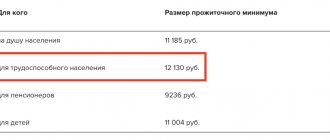Features of minimum wage payment
There are two types of “minimum” wages:
- federal - established at the state level and uniform for all subjects of the Russian Federation;
- regional - depends on the characteristics of a particular region, is developed by officials at the local level and is mandatory for use only in one specific territory, and it cannot be lower than the federal one.
It should be noted that not all enterprises are required to comply with the regional “minimum wage”.
If, for any legal reason, an organization refuses to properly pay employees the local minimum wage, it has every right to apply the federal minimum wage.
Minimum wages - types, size, regulatory framework
According to Art.
3 of the Law “On the Minimum...” of June 19, 2000 No. 82-FZ, the minimum wage is a conditional value that is used to regulate wages and assign benefits or other social payments from the compulsory social insurance fund. At the same time, the use of minimum wages for other purposes is prohibited by law. We wrote about calculating sick leave in the article
In view of the provisions of Art. 1 Federal Law No. 82, the minimum wage is established only by federal law. From 01/01/2018, its monthly amount was 9,489 rubles; from 05/01/2018 it was increased to 11,163 rubles. From 2019, the procedure for determining the minimum wage is subject to adjustment: from this day on, it is equal to the cost of living for the working-age population in Russia as a whole, calculated for the 2nd quarter of the previous year. From January 2021, the minimum wage is 12,130 rubles.
From 2021, the method of calculating the minimum wage has changed again. The minimum wage for the next year is set based on the median salary, and cannot be less than the subsistence level of the working population. From January 1, 2021, the minimum wage is 12,792 rubles.
Read about the minimum wage in Moscow and the region in the article
According to Art. 133 of the Labor Code of the Russian Federation, the monthly wage of an employee who has fully worked the required working hours and, accordingly, has fulfilled his job duties in full, cannot be less than the minimum wage.
The ConsultantPlus Guide will tell you which payments are not taken into account when comparing an employee’s salary with the minimum wage. Take advantage of free trial access to the system to avoid making mistakes in calculations and avoid fines.
Types of minimum wages
Art. 133.1 of the Labor Code of the Russian Federation gives the right to constituent entities of the Russian Federation to establish a minimum wage in an amount different from the federal one. In this case, the minimum wage must be established by a tripartite agreement concluded between representatives of workers and entrepreneurs with the participation of representatives of regional authorities. This right should not infringe on the interests of citizens employed in the region, therefore, the regional minimum wage, according to the same article, can only exceed the federal one and is determined taking into account the cost of living for the working population in a particular region.
Organizations that did not participate in the development and signing of the regional agreement have the right to join it within a month or refuse such accession by sending a reasoned written refusal to the relevant authority. In this case, their management must attach to the refusal a protocol of consultations between representatives of the organization and employees of the company (trade union), as well as proposals on the timing and measures that the company plans to take to increase wages to the level of the regional minimum wage.
If the organization does not refuse to comply with the regional agreement within 1 month, it is considered to have accepted its terms by default. Accordingly, from the moment of the official publication of this agreement, the organization will need to pay its employees wages based on the regional minimum wage, and not the federal one.
When is an additional payment required?
Not all workers earning less than the minimum wage can qualify for additional payment up to the minimum wage.
This requirement is established only for those who work on a full-time schedule, namely 8 hours a day or 40 hours a week.
If a person works, for example, part-time, then he can receive half of the minimum wage and this will not be a violation of the law. In the same way, payment below the minimum wage to an employee working on a part-time basis will not be considered a violation - in this case, the salary is calculated in proportion to the time worked.
Bringing wages up to the minimum wage
Bringing wages up to the minimum wage is an important point based on legal norms. The employer must carry out the surcharge process in such a way as to comply with legal requirements and not violate the labor rights of its employees.
How can an employer organize additional payment?
In order for an employer to organize an additional payment up to the minimum wage, it is initially necessary to decide which employee is entitled to it. It is necessary to find out which workers’ wages are below the minimum value, and for this it is necessary to calculate wages taking into account the minimum wage. This action must be performed monthly, since compensation and incentive payments (unlike salary) may not be permanent.
The rules for organizing additional payments should be fixed in the company’s local documentation, for example, in the regulations on remuneration. By signing the familiarization sheet, employees will know that they can count on additional payment if the accrued salary is below the minimum wage. In addition, the payroll accountant will have clear instructions on how to act in this situation.
How to issue an order to establish an additional payment
To establish an additional payment up to the minimum wage, the company management issues an order in free form, since the law does not regulate a unified form for this document. The order template is developed by the employer independently in accordance with the peculiarities of its document flow and the requirements for the preparation of internal documentation.
The order must be issued on the basis of some document indicating the need to bring wages to the minimum wage . For example, this could be a memo from an accountant or personnel officer, which reflects reasonable requirements for establishing additional payments.
Regardless of who exactly is involved in drawing up the order, it must be signed by the head of the company or a person with appropriate authority. This document must be familiarized with the signature of all employees who are directly affected by this order. This will indicate that the employees are familiar with the director’s order and agree with it.
The issued order must be registered in the journal of personnel documents or in the journal of general documents for the company (depending on the peculiarities of document flow in the organization). The journal reflects the date, number and name of the document, as well as a brief description of the essence of the issue.
When drawing up an order for additional payment, it must reflect the following information:
- date, number and place of drawing up the order;
- name and other details of the company;
- a link to the legal act in accordance with which the additional payment is made;
- decree on the assignment of additional payments to specific employees;
- validity period of the surcharge;
- signature and full name of the head of the company;
- signatures and full names of employees familiar with the order.
Calculation of the amount of additional payment up to the minimum wage
The calculation of the additional payment up to the minimum wage depends on the exact reason for which it is made, for example, during shift work, external and internal part-time work, etc.
How to calculate surcharges in commercial organizations
When determining the amount of additional payment up to the minimum wage in commercial organizations, it is necessary to focus on the federal or regional minimum wage.
For example, in 2021, the minimum wage in Novosibirsk, taking into account the regional coefficient, is 13,536 rubles. Employee Semenov receives 12,000 rubles for a fully worked month. Accordingly, the employer must set him a monthly additional payment in the amount of 1,536 rubles. (13,536 - 12,000).
How to calculate surcharges in budgetary organizations
If a budget organization is financed from the federal budget, then the additional payment to the minimum wage is determined based on the federal minimum wage. At the same time, there is no dependence on which particular constituent entity of the Russian Federation the institution is located in and whether a regional agreement on the minimum wage is in force there.
The procedure for calculating additional payments is the same as in a commercial organization. For example, if an employee Semenov lives in Novosibirsk, works in a budget organization and has a salary of 12,000 rubles, then he is not entitled to the amount of monthly additional payment, since the federal minimum wage in 2021 is 11,280 rubles, which is less than his salary.
Additional payment up to the minimum wage for piecework wages
If an employee works on a piecework basis, his work is paid at piecework rates. In this case, the employer must establish labor standards, namely the production rate and time in accordance with the level of organization of work and production in the company.
If an employee’s work activity for a month fully complies with the production standards and working hours established for him, then he must receive wages not lower than the minimum wage. If the salary is below the established minimum value, the employer makes an additional payment.
If the labor standards established by the employment contract are not fully met, for example, the employee did not work the required time, then the minimum wage is adjusted in proportion to the time worked (standards met). Based on this, it is determined whether the employee is entitled to additional payment or not.
Additional payment up to the minimum wage for a shift work schedule
With a shift work schedule, it is assumed that summarized working time recording will be used. In accordance with this, it is necessary to pay attention to the following points:
- the tariff rate is calculated based on the salary and hours of the working week (40, 36, 24);
- When an employee works a full month, taking into account the schedule, he is paid by the hour, taking into account the minimum wage. In this case, no additional payment is made;
- if an employee has a part-time pay and at the same time he worked the entire month according to the schedule, he is entitled to proportional payment by the hour, taking into account the minimum wage;
- if an employee does not work according to schedule, but through no fault of his own, he is entitled to an additional payment up to the minimum wage in accordance with Art. 155 TK.
Additional payment up to the minimum wage for an incomplete month worked
If the time worked is incomplete, the minimum wage must be determined in proportion to the time worked. This procedure is used, for example, when hiring or dismissing an employee, due to illness, absence from work for a valid reason, etc.
An example of determining the need for additional payment up to the minimum wage can be presented in this form.
Employee Semenov works a 40-hour work week. In December 2021, the standard working hours is 175 hours. Of these, Semenov worked 135 hours. The region has a federal minimum wage of 11,280 rubles.
To calculate the minimum earnings of an employee, you need to divide the minimum wage by the standard time for the month and multiply by the hours actually worked:
11,280: 175 * 135 = 8,701.71 rub. — Minimum wage for 135 hours of work in December.
If Semenov’s salary is higher than this value, then there is no need to make an additional payment, otherwise it is necessary to bring the wages up to the minimum wage.
Additional payment up to the minimum wage for part-time workers
The need for additional payment up to the minimum wage for external and internal part-time workers is determined in the same way as for ordinary employees. It must be taken into account that part-time workers, as a rule, work part-time.
External
The additional payment up to the minimum wage for external part-time workers is determined in accordance with the rate at which he was accepted. For example, if he is hired at 0.5 rates, then his accrued salary must be at least half the minimum wage, otherwise an additional payment must be made.
Internal
Additional payment to the minimum wage for internal part-time workers is made in the same way - taking into account the rate at which he was accepted. For example, if an employee is hired for an internal part-time job at 0.25 rates, then his salary for a fully worked month should be no less than 1/4 of the minimum wage.
It is important to take into account that for internal part-time jobs, wages are compared with the minimum wage separately, that is, for both the main position and part-time jobs. It is not allowed to sum up all payments for both positions and compare this indicator with the minimum wage.
How to pay extra when processing
If an employee had overtime in a calendar month, it is necessary to find out what his salary would have been under standard working hours. Basically, wages, taking into account overtime, will be more than the minimum wage, but when recalculated to the minimum wage, it turns out that the employee did not receive enough money.
Example
Employee Semenov works according to schedule. In December 2021, the standard working time is 175 hours, and Semenov worked 180 hours and received a salary of 11,300 rubles. The region uses the federal minimum wage - 11,280 rubles.
In fact, the salary received is more than the minimum wage, but it includes payment for overtime. In this case, it is necessary to calculate how much Semenov would have received if he had worked his quota for a month without overtime, i.e. 175 hours:
11,300: 180 * 175 = 10,986.11 rub.
It turns out that if he worked the full monthly quota, Semenov would receive a salary less than the minimum wage, and therefore, during overtime, the salary was accrued incorrectly. It should be like this:
11,280: 175 * 180 = 11,602.29 rubles. - when processing 5 hours in December.
Accordingly, the additional payment will be equal to: 11,602.29 - 10,986.11 = 616.18 rubles.
How to pay extra correctly when summed up accounting
When summing up accounting, it is necessary to determine which period is used for calculation, for example, a quarter or a year. Based on the results of this period, for the calculation it is necessary to determine in which months the employee had shortfalls and overtime. Based on this, it will be clear in which cases an additional payment to the minimum wage is needed, and in which cases it is not.
For example, an employee works on a salary system, but with cumulative accounting. In this case, it may have both defects and rework within one month. If for the month when the employee has a shortfall, he was paid a salary, there is no need to recalculate anything. If an employee had overtime in a month and was paid a salary, then the salary must be recalculated taking into account this overtime.
How to pay extra when on vacation
If an employee’s vacation falls during part of the working time of the month, then the employee automatically works less during this period and, accordingly, he is paid a smaller salary. In this case, it is necessary to determine whether the salary corresponds to the minimum wage based on the actual time worked.
Example
Employee Semenov worked in December until the 13th (i.e. 10 days), and went on vacation from December 16th. He received a salary of 10,000 rubles. This is less than the federal minimum wage of 11,280 rubles, which is used to set the minimum wage.
It is necessary to determine the minimum wage for hours worked based on the minimum wage:
11 280 : 22 days * 10 days = 5,127.27 rub.
The calculated value is less than the actual salary paid for the time worked, and therefore there is no need to make an additional payment in this case.
What happens if you don’t pay extra to the “minimum wage”
If the management of an organization does not have the desire or ability to make an additional payment to an employee up to the minimum wage when it is obliged to do so, it automatically puts itself at risk. An employee has the right to complain about such an employer to the labor inspectorate, prosecutor's office or court.
As a punishment for violating the current labor legislation, an administrative fine is provided for the enterprise and senior officials.
Thus, increasing wages to the “minimum wage” in situations established by law is absolutely necessary. And for this you need to carry out a number of mandatory procedures.
What is included in the minimum wage
According to Art. 129 of the Labor Code of the Russian Federation, the amount of remuneration includes not only salary, but also bonuses, rewards for length of service, compensation, overtime pay and other payments. However, the Constitutional Court of the Russian Federation, in its Resolution No. 17-P of April 11, 2021, indicated the incompetence of including in the minimum wage payments for overtime work, work at night, weekends and non-working holidays.
The Constitutional Court supplemented this list with its Resolution No. 40-P of December 16, 2021, which prohibited the inclusion in the minimum wage of additional payments for combining positions and performing additional work not included in the main job duties.
Even earlier, by his resolution of December 7, 2021 No. 38-P, he established that regional coefficients and percentage bonuses for work in the Far North are also not included in the minimum wage, but should be accrued to it.
Who should sign
All orders are always written on behalf of the director of the organization - this is one of the main features of this document. In this regard, regardless of who is directly involved in drawing up the order - a secretary, a legal adviser or some other employee - he must hand over the completed form for signature to the main person of the enterprise, since without his autograph the order will not be valid.
All other company employees named in it must also sign the order - in this way they will attest that they are familiar with the order and agree to comply with it.
Important points before calculation
Thus, it is necessary to state the fact that it is legally permissible to approve salaries for employees at an enterprise below the minimum wage level. But in this case, the difference must be compensated by other payments.
As mentioned above, these may include allowances and bonuses. However, if even taking into account these additional charges, the amount of the total salary remains below the minimum, then you can issue an additional item as an additional payment to the minimum wage.
In any case, if a person has worked the amount of time established by the standards, he cannot receive income below the minimum wage. This norm is guaranteed by the state, and its failure to comply entails administrative punishment of the responsible persons, which we will discuss below.
Administrative responsibility may also be assigned to the chief accountant or other person responsible for calculating and paying wages to the personnel of the enterprise.
In addition, it should be taken into account that the accrued salary with all additional payments and allowances should not be less than the minimum wage, but the actual income paid minus taxes and fees may be less than the minimum wage.
The next step is the signing of the order by the director. Based on it, the accounting service calculates the additional payment up to the minimum wage. This is the generally accepted norm.
Moreover, it is not necessary to issue a special document to justify additional charges to the level of the minimum wage. For these purposes, you can use a general order on the minimum wage at the enterprise. But a prerequisite is the presence in it of a clause that would oblige the accounting department to accrue the appropriate amount to employees who have an income less than the established norm.
A sample order for additional payment up to the minimum wage is given below.
In addition, all calculations for calculating the corresponding salary increases for each employee must be detailed and attached to the order journals for the period being calculated. If necessary, they are provided to regulatory authorities.
However, as practice shows, ideal conditions are not always found, and in order not to get into trouble with additional amounts to the minimum wage, you need to have a good knowledge of labor legislation and be able to use its norms in the appropriate situation.
This methodology is valid in cases where both additional payments to the minimum wage for external part-time workers and internal ones are calculated. We’ll talk about specific nuances a little below.
Nowadays, economic efficiency should be at the forefront of every enterprise. Not least in this matter is the rational and practical use of labor. The easiest way, of course, is to save on payroll by simply cutting the salaries of specific employees, but you can also use other management tools, and many managers use them.
For example, it is quite beneficial for an enterprise to use internal part-time workers in its work, especially in types of work that do not require full-time employment. Not every person, for example, will agree to work for half the minimum wage. But if this person already works at your company, receiving a fairly decent salary, then he can happily take on several additional functions for a small additional payment, and often without increasing actual working hours.
This situation suits both the employee and the employer, who, moreover, entrusts new functions not to an unknown person on the street, perhaps also working for another company, but to a trusted employee. For the company administration, the introduction of this practice simultaneously helps to resolve the issue of the efficiency of wages and labor shortages. Therefore, at present, the use of internal combination is gaining increasing popularity in enterprises.
But, unfortunately, one must take into account the fact that internal combination can not be used for all employees and not in all cases. For example, according to current legislation, part-time workers cannot be employees who are involved in work that is harmful to health or physically difficult. It is also not allowed for minors to combine two positions.
We suggest you read: Length of service has been removed from salaries
In addition, it should be said that members of the government, employees of the prosecutor’s office and the Central Bank cannot combine positions.
When appointing a part-time position, it is also necessary to take into account his abilities, education and many other factors. For example, a tractor driver is unlikely to be able to work as an accountant and vice versa, naturally, if he has not undergone additional training. If a manager appoints an incompetent person to a position associated with a risk to the life or health of other people, then such a decision may entail criminal liability for the director of the enterprise.
Some employers believe that if their employee is an internal part-time worker and the total amount of his salary exceeds the minimum standard, then no additional charges need to be made. This approach is fundamentally wrong, although it is clear that it appeals to company owners. After all, in this case they do not incur additional costs to compensate for the difference.
But in fact, additional payments up to the minimum wage for internal part-time workers should be made for each workplace separately. Even if in total the employee, working at one and a half times the rate, receives income exceeding the minimum wage. Otherwise, you not only unreasonably reduce the real wages of your employees, but also underestimate the taxes that the company should pay on employee income.
3500 700 350=4550 rubles.
The additional payment to the minimum wage for guards will consist of the difference between the minimum wage (5965 rubles) and the amount of accrued income: 5965 – 4550 = 1415 rubles.
5965*0.5=2982.50 rubles.
2982.50-2500=482.50 rubles.
As you can see, the additional payment to the minimum wage for this employee as a watchman will be 1,415 rubles, and as a territory cleaner - 482.50 rubles, which in the end will give a very good amount - 1,897.50 rubles.
If we initially proceeded from the total amount of earnings for all positions of a given employee (7,050 rubles), then it would immediately exceed the minimum wage (5,965 rubles), and the employee would not receive any additional payment. But again, this approach would be wrong.
Salary composition - comparison to the minimum wage
— remuneration for labor depending on the qualifications of the employee, complexity, quantity, quality and conditions of the work performed (salary); — compensation payments (additional payments and compensation allowances for work in hazardous conditions, in the Far North, etc.);— incentive payments (additional payments and bonuses of an incentive nature, bonuses and other similar payments).
Separately, it makes sense to focus on “northern” companies. Recent judicial practice indicates that they must compare the salaries of their employees with the minimum wage, taking into account regional coefficients and other additional payments (see the Supreme Court rulings of September 19, 2016 N 51-KG16-10, of August 8, 2021 N 72- KG16-4).
https://www.youtube.com/watch?v=poJd63Dc0KM
The judges pointed out that the provisions of the current labor legislation do not provide for a condition according to which the amount of the salary as a component of the monthly wage cannot be lower than the minimum wage. By virtue of Article 133 of the Labor Code, a mandatory condition for calculating monthly wages for an employee who has worked the full working hours during this period and fulfilled labor standards (labor duties) is to establish its amount not lower than the minimum wage.
In the case under consideration, the workers’ wages, taking into account the “northern” bonus, exceeded the minimum wage. Therefore, the company should not pay its employees anything extra. Please note! From the provisions of Article 133.1 of the Labor Code it directly follows that the minimum wage is established per calendar month and applies to the salary of an employee who has fully worked the standard working hours for the month and fulfilled the labor standard.
How to raise your salary
In order for employee salaries to comply with the new minimum wage as of July 1, 2021, employers need to take certain actions in advance. Moreover, there are several options for solving the problem. So, you can increase the salary of employees. It must be said that this is perhaps the least successful way to bring employee salaries up to the minimum wage.
At a minimum, you will have to make changes to the staffing table, draw up and sign an additional agreement to the employment contract with employees, etc. (Article 72 of the Labor Code). Considering that the legislator systematically and regularly increases the minimum wage (both at the federal level and at the regional level), it makes sense, so to speak, to take a different route.
In particular, as an option, the wage regulations should provide for the payment of an additional payment to the accrued salary of employees in the event that, based on a fully worked month, it turns out to be less than the minimum wage (federal or regional). The only thing that do not forget to reflect in the documents is that in any case, the employment contract drawn up with each employee must contain a reference to this provision.
- funds from the federal, regional or local budget (for budgetary organizations);
- employer funds (for other organizations).
Grand total
Thus, we see that compliance with the minimum wage level is one of the most important tasks of the state. In order not to enter into conflict with him, the employer must also strictly comply with these standards. Not to mention that in enterprises that try to maintain high standards in the field of remuneration, employees value their jobs more and show better results.
Since currently, due to economic efficiency, the use of internal combination is becoming more widespread in enterprises, it is very important for the administration of business entities to know the legislative aspects of such working methods. In particular, some nuances should be taken into account when calculating additional payments to internal part-time workers up to the minimum wage level. This is important so that in the future you do not run into lawsuits from employees or penalties based on the results of inspections by regulatory authorities.
The main thing you need to remember is that the additional payment for part-time workers up to the minimum wage is calculated according to the same scheme as for ordinary workers, only for each position separately.









